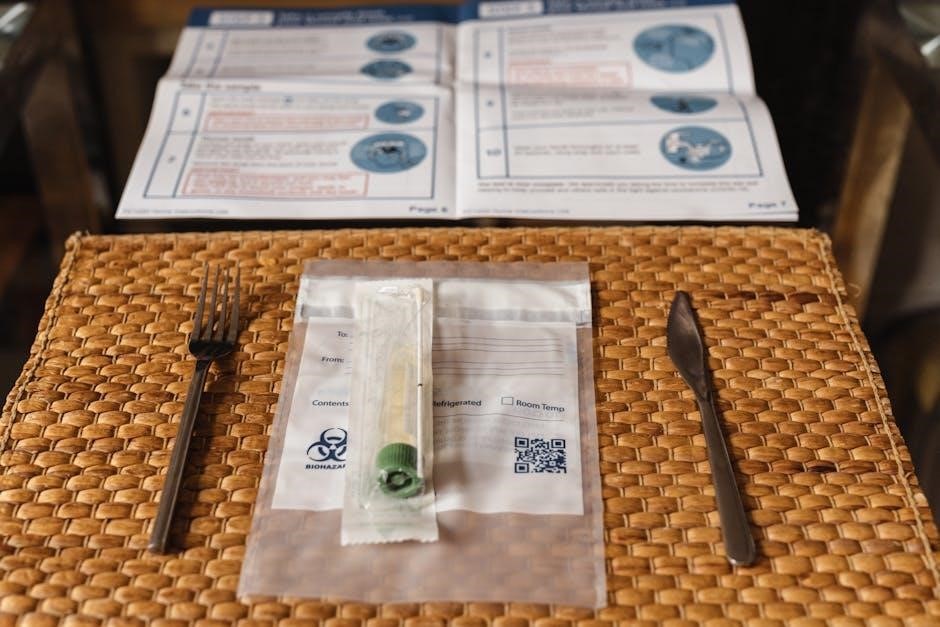
Surgifoam is a sterile, absorbable gelatin sponge or powder used for hemostasis in surgical procedures. It is water-insoluble, malleable, and designed to control bleeding effectively.
1.1 Overview of Surgifoam
Surgifoam is a sterile, absorbable gelatin sponge or powder designed for hemostatic use in surgical procedures. It is water-insoluble, malleable, and effective in controlling bleeding. Surgifoam is derived from porcine gelatin and is biocompatible, making it suitable for use in various surgical settings. Its unique structure allows it to absorb blood and fluids, promoting clot formation at the bleeding site. Available in both sponge and powder forms, Surgifoam offers versatility for different surgical needs. It is intended for application directly to bleeding surfaces to achieve hemostasis efficiently. Surgifoam is widely used in medical procedures due to its reliability and biocompatibility. Always refer to the Instructions for Use (IFU) for proper application and handling.
1.2 Historical Development and Use
Surgifoam, an absorbable gelatin sponge or powder, has a long history of use in surgical procedures. Introduced in the mid-20th century, it was developed to address the need for effective hemostasis in operating rooms. Derived from porcine gelatin, Surgifoam is biocompatible and safe for use within the body. Over time, its design and manufacturing have evolved to improve its performance and versatility. Initially used in general surgery, its applications expanded to specialized fields like neurosurgery and orthopedics. Surgifoam gained popularity for its ability to control bleeding without leaving permanent material in the body. Its historical use includes both civilian and military surgical practices, where controlling hemorrhage is critical. Today, it remains a trusted tool for surgeons worldwide, with ongoing advancements ensuring its effectiveness in modern surgical scenarios.

Preparation of Surgifoam for Use
Preparation involves cutting Surgifoam to the desired size and shape. Compress the sponge before application to ensure proper fit and effectiveness in controlling bleeding.
2.1 Cutting Surgifoam to the Desired Size and Shape
Cutting Surgifoam to the appropriate size and shape is essential for effective application. Use sterile scissors or a scalpel to trim the sponge or powder to fit the specific bleeding site. Ensure the edges are smooth to prevent irritation and promote even absorption. Proper sizing helps maximize hemostatic effectiveness and minimizes waste. Always handle Surgifoam with sterile instruments to maintain its integrity and prevent contamination. This step ensures the sponge or powder adheres well and functions optimally during surgical procedures.

2.2 Compressing the Sponge Before Application
Compressing Surgifoam before application is a critical step to ensure optimal performance. Gently press the sponge between gloved hands or sterile gauze to remove any air pockets and excess moisture. This step enhances the sponge’s ability to absorb blood and adhere to the tissue. Ensure the sponge remains damp but not soaking, as excessive moisture can reduce its effectiveness. Compression also makes the sponge more pliable, allowing it to conform better to irregular bleeding sites. Properly compressed Surgifoam will have a uniform texture, improving its hemostatic properties and ease of application during surgical procedures. Always handle the sponge with sterile instruments to maintain its integrity and prevent contamination.

Application of Surgifoam
Surgifoam is applied directly to the bleeding site, where it absorbs blood and promotes hemostasis. It can be used alone or with thrombin for enhanced effectiveness.
3.1 Selecting the Appropriate Bleeding Site
Selecting the appropriate bleeding site for Surgifoam is crucial for effective hemostasis. The sponge or powder should be applied directly to the source of bleeding, ensuring proper contact with the tissue. It is essential to choose a site where Surgifoam can adhere and absorb blood effectively. Avoid areas with active infection, as Surgifoam is contraindicated in such cases. The bleeding site should be clean and free from debris to maximize the product’s absorbency and hemostatic properties. Proper placement ensures that Surgifoam can expand and form a stable clot, minimizing the risk of further bleeding. Always follow the instructions for use and consider the surgical context when selecting the application site.
3.2 Holding and Placing the Sponge
Hold the Surgifoam sponge gently but firmly to avoid breaking or tearing it. Use sterile technique to ensure the sponge remains uncontaminated. Place the sponge directly onto the bleeding site, pressing it gently to ensure proper contact with the tissue. The sponge should be positioned to cover the entire bleeding area for optimal effectiveness. When applying, use a pair of sterile forceps if necessary to guide the sponge into place. Ensure the sponge lies flat and does not overlap or bunch up, as this can reduce its effectiveness. The sponge will expand slightly upon absorbing blood, so gentle pressure during placement is sufficient. Proper placement ensures the sponge adheres well and promotes effective hemostasis.
3.3 Techniques for Securing the Sponge
To secure the Surgifoam sponge effectively, ensure it is placed directly on the bleeding site using sterile forceps or gloved hands. Gently press the sponge onto the tissue to enhance adhesion and absorption. Avoid overlapping or bunching the sponge, as this may reduce its effectiveness. If necessary, additional hemostatic agents like thrombin can be applied to the sponge before placement to improve its adherence and hemostatic properties. Once in place, maintain gentle pressure for a few seconds to ensure proper contact with the bleeding surface. The sponge will expand slightly as it absorbs blood, aiding in its natural securing process. Proper placement and pressure are essential for optimal results and to avoid dislodgement during surgery.

Usage Considerations
Surgifoam is used for hemostasis in surgical procedures. It should be applied immediately after opening and not used in infected areas. It can be used with thrombin for enhanced effectiveness.
4.1 Recommended Use in Surgical Procedures
Surgifoam is primarily used for hemostasis in surgical procedures, providing effective control of bleeding. It is recommended to cut the sponge to the desired size and shape before application. The sponge should be compressed and placed directly on the bleeding site, where it forms a gelatinous barrier to promote clotting. Surgifoam is particularly useful in surgeries where traditional methods of hemostasis are challenging. It is malleable and can be shaped to fit various wound types. The sponge is absorbable and can remain in the body, reducing the need for removal. It is essential to use Surgifoam immediately after opening to ensure optimal performance. Always follow the provided instructions for use and avoid application in infected areas. Surgifoam can absorb up to 45 times its weight in blood, making it a reliable choice for surgeons.
4.2 Using Surgifoam with Thrombin for Enhanced Hemostasis
Surgifoam can be combined with thrombin to enhance its hemostatic effectiveness. This combination accelerates the clotting process, making it particularly useful in complex surgical scenarios where rapid control of bleeding is critical. To use Surgifoam with thrombin, the sponge or powder should be soaked in a thrombin solution before application to the bleeding site. This method ensures that the thrombin is evenly distributed, promoting faster coagulation. While Surgifoam is effective on its own, the addition of thrombin can improve its performance in challenging cases. Always follow the instructions for use and ensure proper mixing ratios to avoid compromising the product’s integrity. This combination is a valuable tool for surgeons seeking reliable and efficient hemostasis in demanding surgical environments.
4.3 Avoiding Use in Infected Areas
Surgifoam should not be used in infected areas due to the risk of exacerbating the infection or delaying healing. The product is designed for hemostasis in clean surgical sites, where it promotes clotting and tissue repair. Using Surgifoam in infected areas may introduce bacteria into the gelatin matrix, potentially leading to prolonged infection or complications. Always ensure the surgical site is clean and free from infection before applying Surgifoam. Adhering to this guideline is crucial for patient safety and optimal outcomes. Proper wound assessment and sterilization are essential steps before considering the use of Surgifoam in any surgical procedure. This precaution ensures the effectiveness of the product and minimizes risks to the patient.
4.4 Importance of Using Surgifoam Immediately After Opening
Using Surgifoam immediately after opening is crucial to maintain its effectiveness. The sterile packaging protects the gelatin sponge or powder from contamination and environmental factors. Once opened, exposure to air, moisture, or potential contaminants can compromise its hemostatic properties. Surgifoam is designed to be used in surgical settings where maintaining sterility is paramount. Delaying use after opening may lead to degradation of the material or introduce bacteria, which could affect patient outcomes. Therefore, it is recommended to apply Surgifoam promptly after removing it from its packaging to ensure optimal performance and safety. This practice aligns with standard surgical protocols for absorbable hemostatic agents like Surgifoam.

Contraindications and Safety Precautions
Surgifoam is contraindicated in infected areas, as it may promote bacterial growth. Use with caution in patients with known allergies to gelatin or porcine products.
5.1 When Not to Use Surgifoam
Surgifoam should not be used in the presence of infection, as it may exacerbate bacterial growth or hinder healing. It is also contraindicated for use as a tampon or plug in bleeding sites. Additionally, Surgifoam should not be applied to non-bleeding surfaces or used in cases where hemostasis is not required. Patients with known hypersensitivity to gelatin or porcine-derived products should avoid its use. Furthermore, Surgifoam is not intended for intravascular use or as a substitute for primary wound closure. It is essential to adhere to these contraindications to ensure safe and effective hemostatic outcomes. Always consult the instructions for use and assess patient-specific conditions before application.
5.2 Potential Allergic Reactions and Precautions
Surgifoam contains porcine-derived gelatin, and patients with known hypersensitivity to gelatin or porcine products should avoid its use. Allergic reactions, though rare, can occur, and include symptoms like skin irritation, swelling, or respiratory distress. Precautions should be taken for patients with a history of allergies to similar products. Always ensure proper patient assessment before application. Surgifoam is intended for topical use only and should not be injected or used intravascularly. Monitoring for signs of allergic reactions after application is crucial. Adhere strictly to the instructions for use and consult a healthcare provider if any sensitivities or concerns arise. Proper precautions ensure safe and effective hemostatic outcomes.

Troubleshooting Common Issues
Ensure proper preparation and handling to avoid issues. Apply gentle pressure for adherence. Refer to instructions if problems persist.
6.1 What to Do If Surgifoam Does Not Adhere Properly
If Surgifoam does not adhere properly, ensure the bleeding site is clean and dry. Gently press the sponge to enhance contact. If issues persist, consider reapplying or using additional hemostatic agents. Proper preparation and handling are key to effective adhesion. Ensure the sponge is not overly compressed or damaged. Refer to the instructions for use for guidance on optimal application techniques. If the problem recurs, consult with surgical staff or consider alternative methods to achieve hemostasis. Always follow proper surgical protocols to ensure patient safety and effective outcomes.
6.2 Managing Ineffective Hemostasis
If Surgifoam fails to achieve effective hemostasis, first ensure the bleeding site is clean and free from infection. Verify proper preparation and application of the sponge. In some cases, combining Surgifoam with thrombin may improve its efficacy. If bleeding persists, consider using additional hemostatic agents or techniques. Always follow the instructions for use and consult with surgical staff if issues remain unresolved. Proper handling and adherence to surgical protocols are crucial for successful outcomes. Persistent ineffective hemostasis may require alternative methods to ensure patient safety and procedural success.
6.3 Dealing with Adverse Effects
While Surgifoam is generally safe, potential adverse effects may include allergic reactions or localized inflammation. Monitor the patient for signs of adverse responses, such as redness, swelling, or unusual pain. If an allergic reaction occurs, remove the sponge immediately and consult a medical professional. In rare cases, inflammation at the application site may require additional treatment. Document all adverse effects and report them to the appropriate medical authorities. Ensure proper wound care to prevent infection and promote healing. Always follow the instructions for use and consult with healthcare providers if unusual symptoms persist. Patient safety should remain the top priority, and any adverse effects should be addressed promptly to avoid complications.

Post-Application Care
After applying Surgifoam, monitor the bleeding site closely to ensure hemostasis and proper healing. Remove the sponge if necessary, following appropriate medical protocols.
7.1 Monitoring the Bleeding Site
After applying Surgifoam, it is essential to closely monitor the bleeding site to ensure effective hemostasis and proper healing. Regularly inspect the area to confirm that bleeding has ceased and that the sponge is functioning as intended. Look for signs of complications, such as excessive swelling, redness, or discharge, which may indicate infection or improper absorption. Maintain sterile conditions to prevent contamination and promote healing. If bleeding persists or recurs, additional interventions may be necessary. Monitoring should continue until the site is fully healed, ensuring that Surgifoam has served its purpose without adverse effects. Proper post-application care is critical to achieving optimal surgical outcomes and minimizing potential complications.
7.2 Removing Surgifoam if Necessary
While Surgifoam is typically absorbable and does not require removal, there may be instances where removal is necessary, such as if the sponge is ineffective or causing complications. If removal is needed, it should be done gently to avoid disturbing the surrounding tissue or causing further bleeding. Use sterile technique and irrigate the site with saline solution to loosen the sponge if it has adhered. Once removed, inspect the area for any remaining debris and ensure hemostasis is maintained. Proper disposal of the used sponge is essential to prevent contamination. Always follow surgical protocols and consult the instructions for use if unsure about the removal process. Monitoring the site after removal is crucial to ensure healing and prevent infection.

Advanced Techniques
Surgifoam can be adapted for complex scenarios, including combining with thrombin for enhanced hemostasis or layering for deep wounds, optimizing its absorbable and malleable properties.
8.1 Using Surgifoam in Complex Surgical Scenarios
In complex surgeries, Surgifoam’s malleability allows it to conform to irregular bleeding sites. It can be layered for deep wounds or used in combination with thrombin for enhanced hemostasis. Surgeons often mold the sponge to fit into challenging anatomical spaces, ensuring effective bleeding control. Its absorbable nature minimizes complications, making it ideal for delicate procedures. Additionally, Surgifoam can be applied laparoscopically or in minimally invasive surgeries, where precision is critical; Its versatility in complex scenarios underscores its value as a reliable hemostatic agent in modern surgical practices.
8.2 Combining with Other Hemostatic Agents
Surgifoam can be effectively combined with other hemostatic agents to enhance its performance in complex surgical scenarios. For instance, it can be used alongside thrombin or fibrin sealants to create a more robust hemostatic effect. This combination is particularly useful in cases where heavy bleeding or challenging anatomy requires additional control. Additionally, Surgifoam can be layered with other absorbable materials to manage deep or diffuse bleeding sites. Its malleability allows it to integrate seamlessly with other agents, ensuring optimal results. This versatility makes Surgifoam a valuable tool in surgeries requiring tailored hemostatic solutions. By combining it with other agents, surgeons can address a wide range of bleeding challenges effectively.

Regulatory and Compliance Information
Surgifoam is FDA-approved for hemostatic use in surgical procedures. It must be stored in a sterile environment and disposed of according to medical waste regulations to ensure safety and compliance.
9.1 FDA Guidelines and Approvals
Surgifoam is FDA-approved as a hemostatic agent for use in surgical procedures. It meets rigorous safety and efficacy standards, ensuring its reliability in medical settings. The FDA guidelines emphasize proper handling and storage to maintain sterility and effectiveness. Surgifoam must be used strictly according to its intended purpose as outlined in the Instructions for Use (IFU). Compliance with FDA regulations ensures patient safety and optimal outcomes. Adherence to these guidelines is mandatory for healthcare professionals to avoid any legal or medical complications. Regular updates from the FDA regarding Surgifoam are available to reflect the latest advancements and safety measures. Always refer to the FDA-approved labeling for the most current information.
9.2 Proper Disposal and Storage
Surgifoam should be stored in a cool, dry place, away from direct sunlight, to maintain its sterility and effectiveness. The product must be kept sealed in its original packaging until use. After opening, any unused portion of Surgifoam should be disposed of promptly, as it is intended for single-use only. Dispose of Surgifoam as biohazardous waste, following local and institutional regulations. Proper storage ensures the product remains viable and ready for use in surgical procedures. Always refer to the Instructions for Use (IFU) for detailed guidance on handling and disposal. Improper storage or disposal may compromise the product’s performance and safety. Adhere to all regulatory guidelines to ensure environmental and patient safety.
Surgifoam is an effective, easy-to-use hemostatic agent ideal for surgical procedures. Its absorbable gelatin composition enhances hemostasis, making it a reliable choice for surgeons.
10.1 Summary of Key Points
- Surgifoam is a sterile, absorbable gelatin sponge or powder designed for hemostasis in surgical procedures.
- It is water-insoluble, malleable, and effective in controlling bleeding when applied to a bleeding surface.
- Preparation involves cutting to size and compressing before application to ensure proper adhesion.
- It should not be used in infected areas and is recommended for immediate use after opening.
- Surgifoam can be used with thrombin for enhanced hemostasis but is not necessary for its function.
- Proper disposal and storage are essential, following FDA guidelines and manufacturer instructions.
- Advanced techniques include its use in complex surgeries and combination with other hemostatic agents.
- Monitoring the bleeding site post-application and removing Surgifoam if necessary ensures patient safety.
Always follow the provided instructions for use to maximize effectiveness and minimize complications.
10.2 Final Recommendations for Use
- Always follow the provided Instructions for Use (IFU) for Surgifoam to ensure safe and effective application.
- Use Surgifoam immediately after opening to maintain its sterility and hemostatic properties.
- Cut and compress the sponge as needed to fit the bleeding site, ensuring proper adhesion and hemostasis.
- Avoid using Surgifoam in infected areas, as it may not be effective and could pose risks.
- Consider using Surgifoam with thrombin for enhanced hemostasis, but note it is not required for its function.
- Monitor the bleeding site post-application and remove Surgifoam if necessary to ensure patient safety.
- Dispose of unused portions and packaging according to FDA guidelines and proper medical waste protocols.
- Consult the IFU for any uncertainties regarding preparation, application, or troubleshooting.
By adhering to these guidelines, Surgifoam can be a reliable and effective tool in surgical hemostasis.